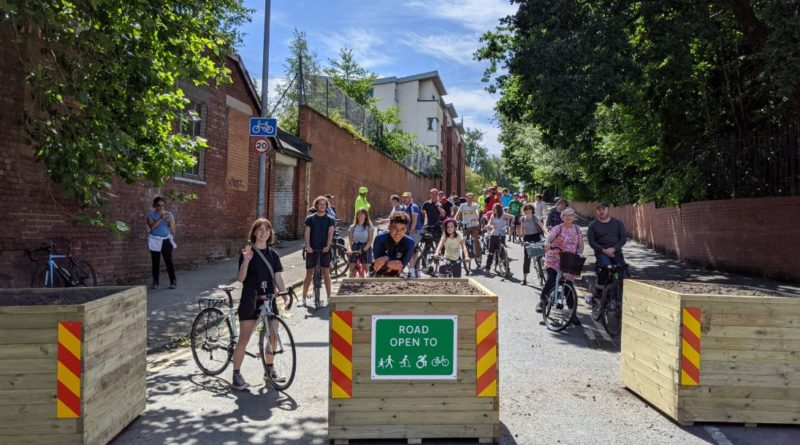Greater Manchester lines up ten Low Traffic Neighbourhoods
Transport for Greater Manchester (TfGM) and its local councils have approved the design of ten Active Neighbourhood schemes (also known as Low Traffic Neighbourhoods) across the Greater Manchester city region.
The project involves design and engineering agents Arup and active travel organisation Sustrans working closely with residents and other stakeholders to design an Active Neighbourhood scheme in each of the Greater Manchester local authority areas.
The ‘Active Neighbourhoods’ project aims to prioritise the movement, health and safety of people over cars. This includes using modal filters such as benches, planters or bollards to reduce traffic on residential streets, increasing walking and cycling for local journeys, and creating quieter, more attractive places for residents to chat and children to play. Such developments have had a rocky start to life across the country, with politicians seen to be bowing to pressure from a minority of motorists in some instances, although where schemes have been allowed to flourish residents have quickly warmed to their benefits.
The Active Neighbourhood schemes form of a 10-year plan for Greater Manchester to deliver the UK’s largest joined-up cycling and walking network, eventually spanning 1,800 miles. The focus is on enabling people to leave the car at home for everyday trips to school or to the shops. This aims to contribute to the one million additional daily sustainable journeys Greater Manchester wants to achieve by 2040, while also having wider benefits to health, congestion and clean air.
Work has begun with communities in Bolton, Bury and Stockport to gather feedback from local residents on what they like and dislike about the streets in their area, whether they would support measures to reduce rat-running, and how they could improve walking and cycling links to local parks, schools and transport hubs.
James Tate, Arup Active Neighbourhoods Project Manager, said: “The COVID-19 pandemic, and measures put in place to mitigate the spread of the virus, have resulted in extraordinary levels of active travel, such as walking and cycling, across the UK. With this, we’ve seen many cities temporarily reap the benefits of improved air quality, safer streets and stronger communities. Local councils now have the unique opportunity to create long-term behaviour change, in which active transport becomes the norm, by putting the right infrastructure in place across the UK’s cities.
“That’s why we are really excited to be delivering TfGM’s Active Neighbourhoods project, focusing on the need to design residential streets that allow people to access local facilities and public transport by foot and by cycle, and delivering the health, air quality and safety benefits of reduced road traffic. We are confident the project will help deliver a huge range of improvements for the Greater Manchester city-region.”
Rory Davis, Principal Urban Designer at Sustrans said: “We’re very excited to be working with local communities on this ambitious programme, which will help transform residential streets across many areas in Greater Manchester that suffer from high road traffic accidents, health problems and poor transport links.
“Community engagement is central to our design process and under normal circumstances this is carried out through group meetings and workshops, so the pandemic throws up obvious challenges. Our team will be working hard to ensure that we give as many local people as possible the chance to have their say through online workshops, printed leaflets delivered to residents, and an interactive website.”
Chris Boardman, Cycling and Walking Commissioner for Greater Manchester, added: “Over the last decade, traffic levels on main roads have barely risen, but journeys on residential streets have risen by a staggering 45%. That’s five billion more miles being driven every year past people’s front doors, mostly by people using what should be quiet neighbourhood streets as shortcuts, and that’s not right.
“By stopping through traffic but keeping full access to homes for people who need to go there, active neighbourhoods prioritise those that call it home.”
Councillor Alan Quinn, Bury’s Cabinet Member for the Environment said: “Creating quieter and safer streets, plus better linkages to local facilities such as shops, parks, schools and transport hubs will have many benefits for the residents of the Whittaker Lane area.
“People that live in low traffic neighbourhoods have better air quality and generally find it easier to embrace positive lifestyle changes due to improved opportunities to be more active and boost physical and mental wellbeing.”
Active neighbourhoods are funded through the Mayor’s Challenge Fund.



